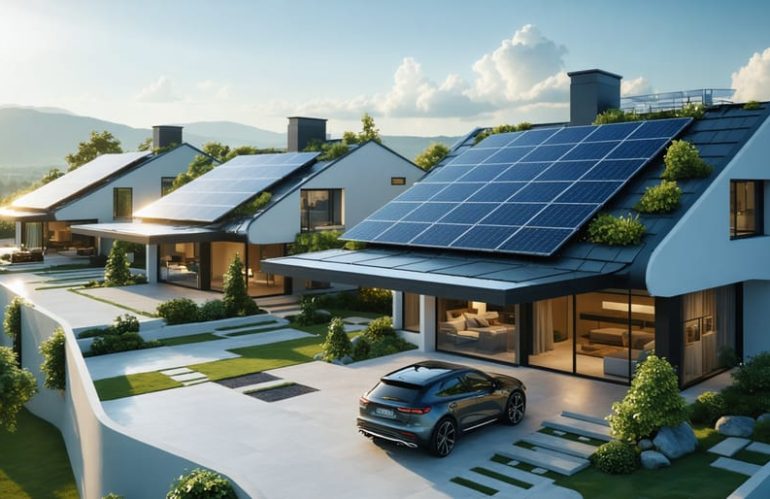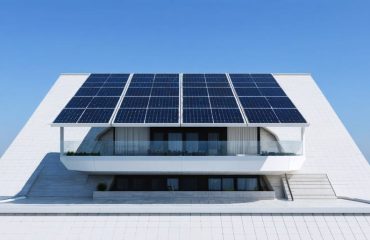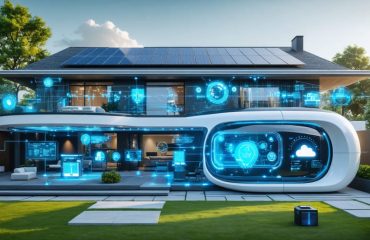Solar panel technology is experiencing a remarkable transformation in 2024, revolutionizing home energy with groundbreaking innovations that promise to reshape residential power generation. Perovskite solar cells, the most exciting advancement in decades, are achieving efficiency rates above 30% while significantly reducing production costs. These next-generation panels, combined with bifacial technology that captures sunlight from both sides, represent a quantum leap from traditional silicon-based systems. Heterojunction technology (HJT) is pushing the boundaries even further, delivering superior performance in low-light conditions and extreme temperatures – a game-changer for homeowners in diverse climate zones. For families considering solar installation, these advancements translate to smaller roof footprints, faster energy payback periods, and more reliable power generation than ever before.
Bifacial Solar Panels: Double the Power Generation
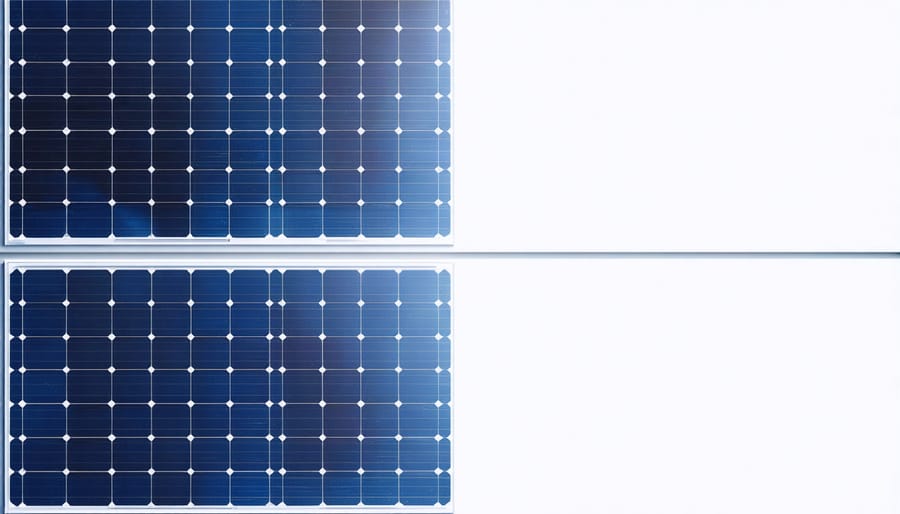
How Bifacial Panels Work
Bifacial solar panels represent a significant leap forward in solar technology by capturing sunlight from both sides of the panel. Unlike traditional panels that only collect light from the front, these innovative panels can absorb reflected light from the ground on their rear surface, increasing their overall energy production by 5-30%, depending on installation conditions.
The technology works by using specialized solar cells that are exposed on both sides, typically protected by a transparent back sheet or glass. When sunlight hits the ground, it bounces back and is captured by the panel’s rear surface, making use of energy that would otherwise be lost. This is particularly effective when panels are installed over reflective surfaces like white gravel, light-colored roofing, or snow.
Bifacial panels are especially beneficial for ground-mounted installations and commercial rooftops, where they can be elevated and tilted to maximize the reflection effect. While they may cost slightly more upfront, the increased energy production often leads to better long-term savings and faster return on investment.
Real-World Performance Gains
Recent real-world data shows impressive gains in both efficiency and cost-effectiveness of modern solar panels. Today’s residential solar installations typically achieve 15-20% better energy conversion than systems installed just five years ago. This translates to approximately $300-400 in additional annual savings for the average household.
Homeowners are reporting shorter payback periods, with many reaching their break-even point in 5-7 years compared to the previous 8-10 years. The latest panels also perform better in less-than-ideal conditions, generating up to 25% more energy on cloudy days than their predecessors.
Installation costs have dropped significantly too, with prices decreasing by roughly 70% over the past decade. A typical 6kW residential system now costs around $15,000-$18,000 before incentives, compared to $50,000+ ten years ago. Plus, modern panels are proving more durable, with many manufacturers now offering 25-30 year warranties, ensuring long-term reliability and peace of mind for homeowners.
Perovskite Solar Cells: The Next Generation
Why Perovskite Matters
Perovskite solar cells represent one of the most promising emerging renewable technologies in the solar industry. Unlike traditional silicon cells, perovskite cells can be manufactured at much lower temperatures, significantly reducing production costs and energy consumption. They’re also incredibly lightweight and flexible, opening up new possibilities for installation on curved surfaces and non-traditional locations.
What makes perovskite truly revolutionary is its impressive efficiency gains. While traditional silicon cells typically convert 15-20% of sunlight into electricity, perovskite cells have already achieved efficiency rates above 25% in laboratory settings. Even more exciting is their potential to be layered on top of silicon cells, creating tandem cells that could push efficiency rates beyond 30%.
The material’s ability to be produced as a liquid solution means it can be printed or sprayed onto surfaces, potentially transforming how we integrate solar power into everyday objects. This versatility, combined with lower manufacturing costs, could make solar energy more accessible and affordable for homeowners than ever before.

When You Can Get It
Many of the latest solar panel innovations are already making their way into the residential market. High-efficiency monocrystalline panels featuring PERC technology are widely available now, while bifacial solar panels are becoming increasingly accessible for home installation, particularly for ground-mounted systems.
Perovskite solar cells, one of the most exciting developments, are expected to enter the mainstream market within the next 2-3 years. Several manufacturers are currently conducting final testing phases and scaling up production capabilities. Transparent solar panels are also progressing rapidly, with some versions anticipated to be available for residential use by 2025.
Multi-junction solar cells are primarily used in commercial applications today, but simplified versions for residential use are expected to become available within the next 5 years as production costs decrease. Solar roof tiles, while currently available, are becoming more efficient and affordable with new versions launching regularly.
The good news is that you don’t need to wait to benefit from advanced solar technology. Many cutting-edge features are already incorporated into current models, with prices continuing to fall as technology improves.
Smart Solar Technology Integration
AI-Powered Optimization
Artificial intelligence is revolutionizing how solar panels operate, making them smarter and more efficient than ever before. Modern solar systems now use AI algorithms to continuously monitor and adjust panel performance based on real-time conditions. These smart systems can predict weather patterns, adjust panel angles, and optimize energy production throughout the day.
Machine learning algorithms analyze data from multiple sources, including weather forecasts, historical performance, and current energy consumption patterns. This allows the system to make instant adjustments to maximize power generation. For example, when clouds approach, AI can preemptively adjust inverter settings to minimize production drops.
The technology also helps identify maintenance needs before problems occur. AI systems can detect when panels are underperforming due to dirt, damage, or wear, allowing homeowners to address issues promptly. Some advanced systems even use drone imaging and thermal sensors to create detailed performance maps of solar arrays.
For homeowners, this means more energy production, lower maintenance costs, and better return on investment. Many modern solar installations now come with user-friendly apps that provide real-time insights into system performance, all powered by AI technology.
Advanced Monitoring Systems
Modern solar panel systems now come equipped with sophisticated monitoring capabilities that put system control right at your fingertips. Through user-friendly smartphone apps and web portals, homeowners can track their solar production in real-time, view historical performance data, and receive instant alerts about any issues that need attention.
These advanced monitoring systems use artificial intelligence to predict maintenance needs and optimize energy production based on weather patterns and usage habits. Many now feature automated panel-level monitoring, which can identify exactly which panel might be underperforming, making maintenance more efficient and cost-effective.
Smart sensors continuously measure factors like temperature, shade patterns, and dust accumulation, providing recommendations for optimal cleaning schedules and performance improvements. Some systems even integrate with smart home devices, automatically adjusting household energy consumption to maximize solar power usage during peak production hours.
What’s particularly exciting is that these monitoring technologies are becoming increasingly affordable and standard in new installations, making it easier than ever for homeowners to ensure they’re getting the most from their solar investment.
Enhanced Durability and Aesthetics
Weather-Resistant Innovations
Recent innovations in solar panel durability have revolutionized their weather resistance, making them more reliable than ever before. New hydrophobic coatings inspired by lotus leaves help panels shed water and dirt effortlessly, maintaining optimal performance even in challenging weather conditions. These self-cleaning surfaces significantly reduce maintenance needs while ensuring consistent energy production.
Advanced encapsulation materials now protect solar cells from moisture and extreme temperatures more effectively. Manufacturers are incorporating reinforced glass and flexible polymer materials that can withstand severe hailstorms and high winds, addressing common durability concerns among homeowners.
Another exciting development is the integration of smart sensors that detect and respond to weather conditions. These sensors can adjust panel angles during storms or heavy snow, preventing damage and optimizing energy collection. Some newer models even feature built-in heating elements that prevent snow accumulation, ensuring year-round functionality.
The latest frames and mounting systems use corrosion-resistant materials and improved designs that distribute weight more evenly, making panels more stable in high winds. These innovations, combined with better edge sealing technology, have extended the average lifespan of solar panels to 25-30 years, providing homeowners with greater long-term value and peace of mind.
Sleek Design Options
Gone are the days when solar panels were bulky, unsightly additions to your home. Today’s solar technology offers sleek, aesthetically pleasing options that complement modern architecture while maximizing energy efficiency. Solar roof tiles, which perfectly mimic traditional roofing materials, have revolutionized how we think about residential solar installations. These innovative tiles blend seamlessly with your existing roof design, making it nearly impossible to distinguish them from regular shingles.
Another breakthrough in solar design is the development of transparent and semi-transparent panels. These can be integrated into windows and skylights, transforming ordinary glass surfaces into power-generating elements without compromising natural light or views. Some manufacturers now offer customizable panel colors and patterns, allowing homeowners to maintain their property’s architectural integrity while embracing renewable energy.
Building-integrated photovoltaics (BIPV) take this concept further by incorporating solar technology directly into building materials. From solar facades to power-generating awnings, these solutions eliminate the need for separate panel installations while maintaining clean, modern aesthetics. Even traditional panel installations have evolved, with newer models featuring slim profiles, hidden mounting hardware, and frameless designs that create a more sophisticated look for your home.
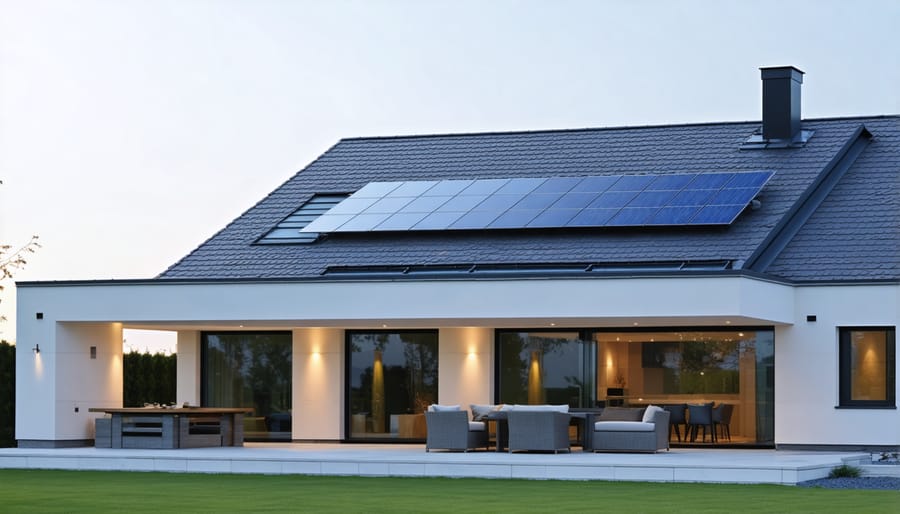
The rapid evolution of solar panel technology represents an exciting frontier in renewable energy. From perovskite cells to bifacial panels and AI-powered optimization systems, these innovations are making solar power more efficient, affordable, and accessible than ever before. As manufacturing costs continue to decrease and efficiency rates climb, we’re approaching a tipping point where solar energy could become the dominant power source for homes worldwide. The future of solar technology looks particularly promising, with researchers predicting that conversion efficiencies could exceed 40% within the next decade. These advancements, combined with improved energy storage solutions and smart grid integration, are paving the way for a more sustainable energy landscape. For homeowners considering solar installation, there’s never been a better time to invest. As these technologies continue to mature and become more widely available, we can expect to see even greater benefits in terms of cost savings, energy independence, and environmental impact. The solar revolution is no longer a distant dream – it’s happening right now, and the possibilities are boundless.

